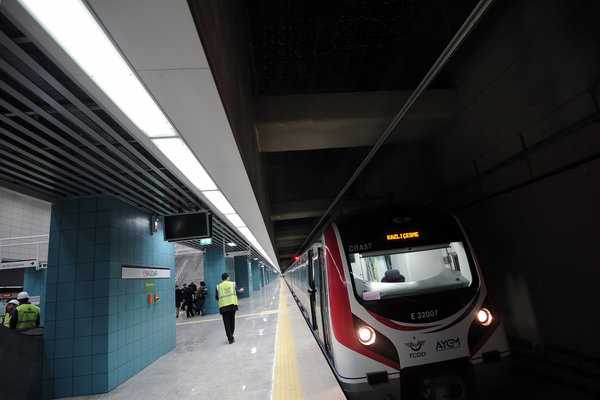
A passenger train gets its final inspection before making the inaugural journey through Istanbul’s Marmaray tunnel beneath the Bosporus strait, providing a rail link between Europe and Asia. (Associated Press / October 29, 2013)
Turkey lifts ban on Islamic head scarves, veils in civil service jobs
Turkey announces reforms aimed at promoting peace with Kurds
Erdogan wrecking Turkey’s image as model democracy, critics say
By Carol J. Williams
October 29, 2013, 1:58 p.m.
Turkey brought to life a 150-year-old vision of the Ottoman sultans on Tuesday with the opening of a submerged tunnel linking Europe and Asia and repurposing the fabled Silk Route from caravan to rail service.
The $4-billion Marmaray project will carry as many as 1.5 million passengers a day from the two sides of Istanbul previously linked only by two bridges and a fleet of small ferries.
Five years behind schedule and the subject of contention between Prime Minister Recep Tayyip Erdogan and critics of his ambitious development plans, the Marmaray tunnel is expected to reduce Istanbul’s legendary cross-Bosporus-strait traffic by 20% and open an uninterrupted rail corridor between trading giants Europe and China.
“The Silk Road is in need of being resurrected for the purposes of reconnecting vital trade arteries between Asia and Europe by rail,” Turkish Transport Minister Binali Yildirim told the Hurriyet Daily News. “This is a project of reuniting civilizations. The Silk Road is not only a caravan route but a road that links East and West.”
Erdogan, at Tuesday’s opening ceremony, appealed for divine guidance in making the tunnel “a benefit to our Istanbul, to our country, to all of humanity.”
The 8.5-mile tunnel of submerged tubular sections connected by flexible, seismically accommodating joints was built with Japanese loans and engineering, and Japanese Prime Minister Shinzo Abe was at the inauguration.
“Japan and Turkey are the two wings of Asia. Let us dream together of a high-speed train departing from Tokyo, passing through Istanbul and arriving in London,” Abe told the officials and dignitaries in attendance, the Reuters news agency reported.
Ottoman Sultan Abdulmejid is credited by Turkish historians with having originated the idea for a tunnel under the Bosporus about 150 years ago. A successor, Sultan Abdulhamid, commissioned architects and engineers to draft plans for the project in 1891, but the work wasn’t undertaken before World War I and the demise of the Ottoman Empire.
Erdogan revived the plans in 2004 and envisioned the tunnel being completed within four years. But important archaeological discoveries during construction delayed the project and presented the Turkish government with additional challenges for preserving the UNESCO-protected historical sites of the Bosporus region.
Among the important finds by the tunnel builders was a Byzantine-era “cemetery” of sunken ships dating back as far as the 4th century. Some 40,000 objects of cultural or historic value were salvaged from the underwater construction site and will be displayed at an archaeological park to be built near the Yenikapi subway station, Deutsche Welle reported.
The new tunnel takes its name, Marmaray, from the Sea of Marmara at the southern end of the Bosporus and ray, the Turkish word for “rail.”
The rail tunnel is just one of Erdogan’s massive projects that are expected to cost the country $250 billion over the next decade. Others include a third bridge over the Bosporus, a 35-mile canal bypassing the strait and the world’s largest airport, near Istanbul.
Critics accuse Erdogan of transforming their ancient metropolis without regard to cost or cultural preservation. The government’s bulldozing of a small Istanbul park in May in preparation for high-rise construction incited massive protests and a brutal police crackdown. The beatings and tear gas attacks that eventually dispersed the demonstrators drew condemnation from human rights groups and have delayed Turkey’s bid to join the European Union.
via Sultan’s vision realized: New ‘Iron Silk Road’ links Europe, Asia – latimes.com.
